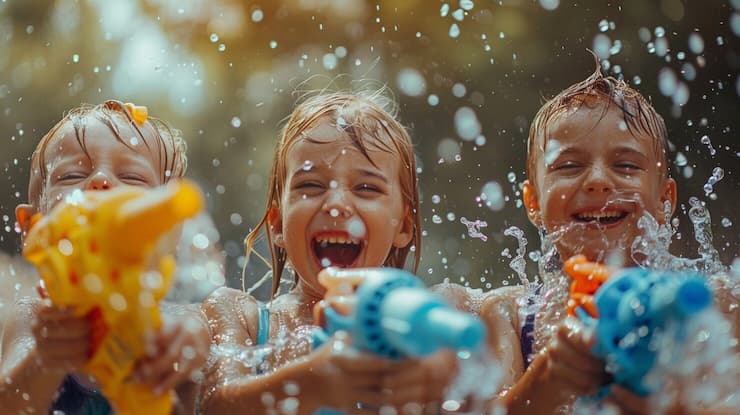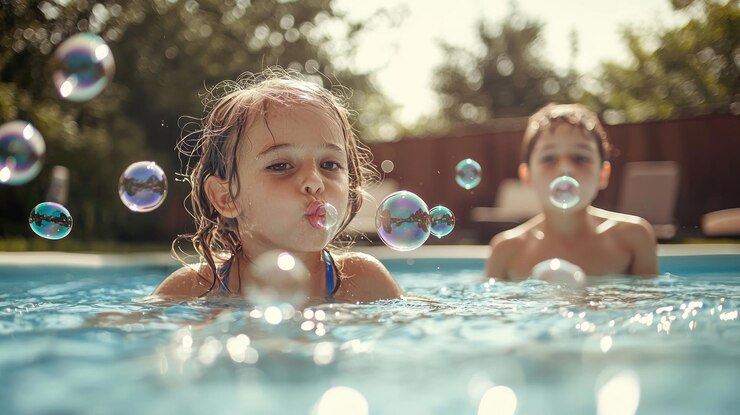Looking for pool games to keep kids entertained all summer? You’re in the right place! I’m Coach Slava Fattakhov, a certified USA Swimming Coach Level 2 with 8+ years teaching kids throughout Miami-Dade and Broward Counties. This guide includes 25+ swimming activities perfect for backyard pools, swim lessons, and pool parties—organized by age and skill level.
Top 10 Pool Games for Kids (No Equipment Needed)
These classic swimming pool games for kids require nothing but water and imagination. Perfect for spontaneous pool fun!
1. Marco Polo
Ages: 5+
Players: 3+
How to play: One player closes their eyes and calls “Marco!” while others respond “Polo!” The caller tries to tag someone based on their voice. Tagged players become the new Marco.
Skills learned: Listening, spatial awareness, treading water
2. Sharks and Minnows
Ages: 5+
Players: 4+
How to play: One “shark” stands in the middle while “minnows” try to swim from one end to the other without being tagged. Tagged minnows become sharks.
Skills learned: Speed, endurance, quick direction changes
3. Red Light, Green Light
Ages: 3+
Players: 2+
How to play: One player is the “stoplight” and calls colors. Green = swim forward, Yellow = slow down, Red = freeze. First to reach the stoplight wins.
Skills learned: Impulse control, listening, swimming technique
4. Freeze Dance (Pool Version)
Ages: 3+
Players: 2+
How to play: Play music while kids swim and splash. When music stops, everyone freezes. Anyone who moves is out.
Skills learned: Body control, water confidence
5. Categories
Ages: 6+
Players: 3+
How to play: One player is “it” and chooses a category (colors, animals, foods). Others pick their answer secretly. When “it” calls their answer, they swim to the other side without being tagged.
Skills learned: Quick thinking, speed swimming
6. Underwater Tea Party
Ages: 6+
Players: 2+
How to play: Players sit on the pool bottom in a circle and “talk” to each other underwater. First one to surface or laugh loses the round.
Skills learned: Breath control, underwater comfort
7. Pool Noodle Joust
Ages: 7+
Players: 2+
What you need: Pool noodles, floats (optional)
How to play: Two players sit on floats or tread water, trying to gently knock each other off balance using pool noodles.
Skills learned: Balance, core strength, treading water
8. Whirlpool
Ages: 5+
Players: 4+
How to play: Everyone walks/swims in a circle in the same direction, creating a current. After 2 minutes, try swimming against the current or floating in the middle.
Skills learned: Teamwork, swimming against resistance
9. Dolphin Races
Ages: 4+
Players: 2+
How to play: Race across the pool swimming like dolphins—keep legs together and use an undulating motion. Add pool noodles for younger kids.
Skills learned: Core strength, rhythmic movement, kicking technique
10. Colors (Fruit Salad)
Ages: 4+
Players: 4+
How to play: One player stands outside the pool while others line up against the wall. Each secretly picks a color. When their color is called, they try to swim to the opposite wall without being tagged.
Skills learned: Speed, strategic thinking
Quick Setup Games with Simple Equipment
These fun pool games for kids use household items you probably already have.
11. Treasure Hunt
What you need: Diving rings, coins, or toys that sink
Ages: 5+
How to play: Scatter objects at the bottom of the shallow end. Kids dive to collect as many as possible in 60 seconds.
Variation: Use different colored rings worth different points.
12. Sponge Relay
What you need: 2 buckets, 2 large sponges
Ages: 5+
How to play: Teams race to transfer water from one bucket to another using only a sponge. First team to fill their bucket wins.
Skills learned: Teamwork, fine motor skills
13. Cup Catch
What you need: Plastic cups, ping pong balls
Ages: 6+
How to play: One player tosses ping pong balls while others try to catch them in floating cups.
Skills learned: Hand-eye coordination, treading water
14. Pool Noodle Balance Race
What you need: Pool noodles
Ages: 5+
How to play: Kids “ride” noodles like horses, racing from one end to the other using only leg kicks.
Skills learned: Balance, kicking strength
15. Water Balloon Toss
What you need: Water balloons
Ages: 6+
How to play: Partners toss a water balloon back and forth, taking one step back after each successful catch. Last team with an unbroken balloon wins.
Skills learned: Catching, gentle hands, teamwork
Swimming Activities for Toddlers (Ages 2-4)
These swimming pool activities for kids focus on water comfort, not technique. Keep sessions short (5-15 minutes) and always end on a positive note.
16. Bubble Magic
What you need: Bubble solution
How to play: Blow bubbles over shallow water while your toddler catches them. Gradually blow them closer to the water surface.
Why it works: Teaches splash tolerance without pressure
17. Toy Fishing
What you need: Floating toys, small net
How to play: Scatter floating toys in knee-deep water. Your toddler “fishes” them out with a net or their hands.
Why it works: Develops coordination and comfort with water movement
18. Animal Parade
What you need: Toy animals
How to play: Float toy animals for “feeding time.” Use cups to pour water for drinking. Create simple stories.
Why it works: Introduces water play through familiar objects
19. Water Painting
What you need: Large paintbrushes, cups of water
How to play: “Paint” the pool deck with water. Watch it disappear and paint again!
Why it works: Extends comfort zone gradually, uses sensory play
20. Splash Catch
What you need: Just hands!
How to play: Make small splashes with your hand. Your toddler tries to “catch” the water. Gradually increase splash size as comfort grows.
Why it works: Builds splash tolerance naturally through play
Coach Slava’s Tip: In my parent-child classes, we spend the first 3 weeks just playing with water—no swimming yet. Comfort always comes before skills. Join Coach Slava’s baby swimming lessons for children from six months old.
Pool Games for Preschoolers (Ages 5-7)
Preschoolers love imagination and can follow simple rules. These water games for kids tap into their natural creativity.
21. Superhero Rescue
What you need: Pool noodles, floating toys
How to play: Kids “rescue” toys using pool noodles without entering deep water. Add towel capes for extra fun!
Skills learned: “Reach or throw, don’t go” safety principle
22. Underwater Detective
What you need: Weighted toys or diving rings
How to play: Place objects in shallow water. Kids search for specific colors or shapes, progressing from looking to retrieving.
Skills learned: Putting face in water, opening eyes underwater
23. Sea Creature School
What you need: Imagination!
How to play: Act like different sea animals—Starfish (float), Dolphin (dive), Crab (sidewalk), Jellyfish (treading).
Skills learned: Different swimming positions and movements
24. Message Bottles
What you need: Plastic bottles, waterproof paper
How to play: Float bottles with simple challenges inside (“Jump in 3 times,” “Make 5 splashes”). Kids retrieve and complete challenges.
Skills learned: Reading, following directions, water confidence
25. Water Limbo
What you need: Pool noodle
How to play: Two people hold a noodle at water surface. Kids go under without touching it. Lower it each round.
Skills learned: Going underwater, breath control
Team Pool Games for School-Age Kids (Ages 8-10)
School-age children thrive on challenges and competition. These fun swimming games for kids add excitement while building real skills.
26. Pool Volleyball
What you need: Beach ball, rope or pool noodle for “net”
How to play: Divide into teams. Keep the ball in the air without letting it touch water. First team to 11 points wins.
Skills learned: Teamwork, treading water, hand-eye coordination
27. Synchronized Swimming
What you need: Waterproof speaker (optional)
How to play: Groups create simple routines with 4-5 moves. Perform for “judges” (parents/other kids).
Skills learned: Coordination, teamwork, water confidence
28. Octopus Tag
What you need: Nothing!
How to play: One player is the octopus. When they tag someone, that player joins the octopus by holding hands. The chain grows until one swimmer remains.
Skills learned: Strategy, swimming while connected, cooperation
29. Relay Races
What you need: Various objects (kickboards, noodles, toys)
How to play: Create relay courses with different challenges—swim with kickboard, underwater swim, backward swim, noodle race.
Skills learned: Different swimming techniques, speed, teamwork
30. Diving Ring Challenge
What you need: 10+ diving rings
How to play: Scatter rings at different depths. Teams compete to collect the most in 2 minutes. Assign point values by depth.
Skills learned: Diving, breath control, underwater swimming
Ready for more? Check out Coach Slava’s competitive swimming courses for kids and teens in Miami to develop advanced skills in a structured, fun environment.
Leadership Activities for Teens (Ages 11+)
These swimming activities for kids prepare responsible teens for lifeguard roles while keeping pool time engaging.
31. Assistant Instructor
Teens shadow an adult, then gradually lead warm-ups and teach one game to younger children under supervision.
Progression: Shadow (Week 1) → Lead warm-ups (Week 2) → Teach game (Week 3) → Run session (Week 4)
32. Rescue Scenarios
Practice realistic but safe rescue techniques in shallow water with cooperative “victims.” Focus on “reach or throw, don’t go” principles.
33. Synchronized Team Routines
Create complex 8-10 move routines. Add music and perform at family gatherings or neighborhood pools.
34. Mentorship Program
Teens “adopt” a younger swimmer for 4-6 weeks, creating personalized games and tracking progress.
Pool Party Games for Kids
Planning a pool party? These games work great for mixed ages and skill levels.
Best for parties:
- Marco Polo (always a hit!)
- Sharks and Minnows
- Treasure Hunt with prizes
- Relay races with teams
- Water balloon toss
- Freeze Dance
- Noodle jousting tournament
Party Tips:
- Assign one adult as dedicated “water watcher” (15-minute shifts)
- Set clear pool rules before anyone enters
- Have towels and water bottles ready
- Create teams to mix ages and abilities
- End with a quieter game as cool-down
Budget-Friendly Pool Games for Kids
You don’t need expensive toys! Here’s what works:
Free games:
- All games in “Top 10” section (zero equipment)
- Follow the Leader
- Water “Simon Says”
- Counting splashes
DIY Equipment (under $5):
- Plastic bottles → diving targets (add sand for weight)
- Kitchen cups → pouring games
- Dish soap → bubble fun
- Tennis balls → floating targets
- Empty milk jugs → water scoops
Community Resources:
- YMCA scholarship programs
- Parks & Recreation free swim days
- Library pool passes
- Church summer programs
Essential Pool Safety Rules
Before trying any pool games for kids, establish these non-negotiable safety rules:
Rule #1: Constant Adult Supervision
- Never leave children alone near water—not even for “just a second”
- Maintain “touch supervision” (within arm’s reach) for non-swimmers
- Designate a “water watcher” who isn’t using phones
- Rotate watchers every 15-20 minutes
Rule #2: Coast Guard-Approved Life Jackets Only
- Inflatable toys are NOT safety devices
- Check weight limits and expiration dates
- Arm floaties can slip off—never rely on them
Rule #3: Know Your Child’s Limits
Stop immediately if you see:
- Blue lips or shivering
- Excessive tiredness
- Difficulty following instructions
- Signs of fear or panic
Rule #4: Clear Pool Rules
- No running on deck
- No diving in shallow water
- No pushing others
- Call for help immediately if needed
Coach Slava’s Rule: Better to end early on a positive note than create one negative memory that takes months to overcome.
Want comprehensive water safety training? Read our complete Water Safety Guide for Parents (includes CPR basics, drowning prevention, and pool-proofing your home).
Frequently Asked Questions
What are the best pool games for kids who can’t swim yet?
Start with shallow water games: Bubble Magic, Toy Fishing, Splash Catch, and Water Painting. Keep water at knee-depth (adult’s knee) and stay within arm’s reach. Focus on fun, not technique.
How long should pool play sessions last?
- Ages 2-4: 5-15 minutes
- Ages 5-7: 15-25 minutes
- Ages 8-10: 25-40 minutes
- Ages 11+: 30-60 minutes
Always end before your child gets tired or cold.
What pool games work for kids with special needs?
For Autism: Use visual schedules, keep routines consistent, start with 5-10 minutes. Try “Mirror Me” (copying simple movements).
For ADHD: Short sessions (15-20 min), frequent activity changes, clear rules. Try “Red Light, Green Light” for impulse control.
For physical differences: Focus on abilities, modify games as needed. “Water Artist” works great (making patterns with one hand).
My 4-year-old is afraid of water. Which games should we try first?
Start with our 6-week gradual approach:
- Weeks 1-2: Observe others playing, read swimming books
- Weeks 3-4: Feet in water while sitting, play with water in hands
- Weeks 5-6: Enter to ankle depth, increase slowly
If fear persists beyond 6 months, consult your pediatrician or contact Coach Slava for specialized support.
What’s the difference between pool toys and safety equipment?
Safety Equipment: Coast Guard-approved life jackets that keep unconscious persons face-up.
Toys: Pool noodles, inflatables, arm floaties. These can deflate, slip off, or fail. NEVER rely on toys for safety—they’re for fun only.
How often should kids practice swimming?
Depends on your goal:
- Overcoming fear: 2-3 times weekly
- Maintaining skills: Weekly
- Building competence: 3-4 times weekly
- Competition prep: Daily
Consistency matters more than duration!
When to Call a Professional
These games work great for most families, but consider professional instruction if:
- Water fear persists after 6 weeks of gentle exposure
- Your child wants faster skill development
- You need specialized techniques for special needs
- Your child shows interest in competitive swimming
- Your own anxiety interferes with teaching
Coach Slava’s Final Tip: “In my 8+ years teaching throughout Miami-Dade and Broward Counties, I’ve seen consistent patterns. The children who succeed aren’t necessarily the naturally talented ones—they’re the ones whose parents started with simple games and stayed consistent. Don’t wait for the ‘perfect’ time. Start today with what you have.”
Make a Splash This Summer: Your Pool Adventure Starts Now
Swimming pool games for kids aren’t just about entertainment—they’re about building confidence, creating memories, and teaching life-saving skills disguised as fun. Whether you’re starting with a nervous toddler who won’t put their toes in the water or coaching a teen ready for lifeguard certification, the key is simple: start where your child is, celebrate small wins, and keep it playful.
Over my 8+ years coaching families throughout Miami, I’ve watched thousands of children transform from fearful to fearless. The secret? It’s never the expensive equipment or fancy techniques. It’s the parents who show up consistently, make water time fun, and know when to challenge and when to comfort.
Remember These Key Takeaways:
- Start Simple – The “Top 10” games require zero equipment and work for almost every age
- Safety First, Always – Constant supervision isn’t negotiable; fun and safety go hand-in-hand
- Follow Their Lead – Some kids need 2 weeks to feel comfortable, others need 2 months. Both are normal
- Consistency Wins – Three 15-minute sessions weekly beats one 2-hour marathon
- Make it Social – Kids try harder when friends are involved
Ready to Take the Next Step?
Explore Coach Slava’s personalized swim programs throughout Miami-Dade and Broward Counties:
- Baby & Parent Classes (6 months+)
- Beginner Lessons (Ages 3-7)
- Intermediate Skills (Ages 8-12)
- Competitive Prep (Teens)
- Special Needs Adaptive Swimming
From parent-child classes to competitive prep, professional guidance accelerates progress while maintaining the fun that makes learning stick.
Contact Coach Slava today to schedule your child’s water confidence assessment!


